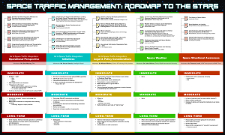Real-Time Space Vehicle and Air Traffic Integration Considering Potential Vehicle Failures and Hazards
Presentation Type
Paper (supporting PowerPoints may be added as Additional Files)
Location
Bass Auditorium
Start Date
26-2-2019 9:15 AM
Abstract
With increasing space vehicle activities the standard approach to air traffic management is proving increasingly insufficient. For each launch or reentry, large blocks of airspace are cleared for long periods necessitating prior coordination between space vehicle operators, regulatory agencies, and air traffic users. This increases costs, slows approval processes, and reduces mission flexibility.
To address, research is exploring “real-time” management of airspace where air traffic is managed and cleared in the event of a failure in the space vehicle behavior. This can provide significant benefits by reducing the required airspace closure to areas which are actually subjected to risk.
This relies on the immediate availability of accurate vehicle information. There are significant challenges to the ability to receive and process data in a sufficient timespan to be able to react and reroute sufficiently. Launch vehicle flight environments are extreme (speeds, altitudes, distance, and forces) which makes observing or receiving signals difficult. Additionally, debris generating events usually result in the loss of vehicle telemetry, potentially before the vehicle’s powered flight has ended.
This paper will explore how to maximize available real-time vehicle information in order to identify vehicle failures and vehicle state at failure (location, speed, configuration). Using knowledge of the vehicle design the extent of the vehicle’s behavior during loss-of-signal can be calculated; leading to the possible spread of debris hazards and actionable spatial and temporal hazard volumes. With reasonable conditions and infrastructure this can allow responsive safe integration of airspace with decreased air traffic impacts.
Area of Interest
NAS Integration
Real-Time Space Vehicle and Air Traffic Integration Considering Potential Vehicle Failures and Hazards
Bass Auditorium
With increasing space vehicle activities the standard approach to air traffic management is proving increasingly insufficient. For each launch or reentry, large blocks of airspace are cleared for long periods necessitating prior coordination between space vehicle operators, regulatory agencies, and air traffic users. This increases costs, slows approval processes, and reduces mission flexibility.
To address, research is exploring “real-time” management of airspace where air traffic is managed and cleared in the event of a failure in the space vehicle behavior. This can provide significant benefits by reducing the required airspace closure to areas which are actually subjected to risk.
This relies on the immediate availability of accurate vehicle information. There are significant challenges to the ability to receive and process data in a sufficient timespan to be able to react and reroute sufficiently. Launch vehicle flight environments are extreme (speeds, altitudes, distance, and forces) which makes observing or receiving signals difficult. Additionally, debris generating events usually result in the loss of vehicle telemetry, potentially before the vehicle’s powered flight has ended.
This paper will explore how to maximize available real-time vehicle information in order to identify vehicle failures and vehicle state at failure (location, speed, configuration). Using knowledge of the vehicle design the extent of the vehicle’s behavior during loss-of-signal can be calculated; leading to the possible spread of debris hazards and actionable spatial and temporal hazard volumes. With reasonable conditions and infrastructure this can allow responsive safe integration of airspace with decreased air traffic impacts.



Comments
Visit the panel session NAS Integration Part 1: Getting There and Back